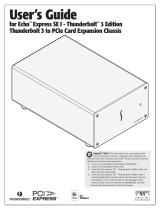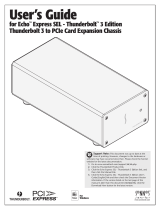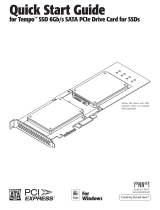Page is loading ...

Quick Start Guide
You Should Have
The following items should be included in your product package:
• One Allegro USB 3.2 Gen 2 Type-C PCIe Card
• Quick Start Guide
The following items may be required for installation:
• Medium Phillips screwdriver
Computer Compatibility
• Mac Pro
®
3,1*, 4,1, 5,1, or 7,1 (2019)
• Windows
®
computer with PCIe slots
• Linux
®
computer with PCIe slots
OS Compatibility
• macOS
®
10.12.6+
• Windows
®
10, 8, 7
• Windows
Server 2019, 2016, 2012, 2008 (64-bit editions)
• Linux
®
Kernel 5.1.9+ (LTS version only)
Thunderbolt™ Compatibility
• Mac
®
, Windows, or Linux computer via a Thunderbolt 2 or
Thunderbolt 3 to PCIe card expansion system
• macOS 10.12.6+
• Windows 10 (64-bit Edition Version 1809 or newer)
• Linux
Kernel 5.1.9+ (LTS version only)
Supported Cables
• USB-C 10Gbps or 5Gbps
• Thunderbolt 3 40Gbps (0.5- or 0.7-meter only)
• Thunderbolt 3 (20Gbps)
* The maximum Apple-supported OS for the Mac Pro 3,1 is OS X 10.11. Dosdude1 offers
patchers to allow installation of newer versions of macOS for the Mac Pro 3,1. The
Apple USB 3 driver in these patched newer versions will support the Allegro card.
Driver Information
For Mac users, the drivers that enable this Allegro card to work in your
computer or Thunderbolt expansion chassis are installed as part of
macOS 10.12.6 and later; the Allegro card is ready to use when you
power on your computer.
For Windows users, the drivers that enable this Allegro card to work
in your computer running supported versions of Windows except
Windows 7 (32- and 64-bit versions) are installed automatically. For
Windows 7 users, please go to https://www.sonnettech.com/support/
kb/kb.php. Navigate to and click the Allegro USB 3.2 Gen 2 Type-C
PCIe Card link, and then click the Driver link. Locate, download, and
install the appropriate drivers. For all other users, update Windows to
the latest version to ensure full support and performance.
For Linux users, the drivers that enable this Allegro card to work in
your computer running Linux Kernel 5.1.9 (LTS version only) and
later are installed automatically; the Allegro card is ready to use when
you power on your computer.
Installation Preparation
Sonnet strongly recommends that you read the section in your
computer’s user manual that addresses PCIe card installation, prior to
installing the Allegro card into your system.
Card Installation Steps
1. Shut down your computer or Thunderbolt-to-PCIe card
expansion chassis, and then open it to access the expansion
card area (PCIe slots); refer to the user’s manual for specific
information.
2. Locate an available PCIe slot and remove its access cover.
3. Remove the Sonnet card from its packaging, and then install it
into the PCI Express slot; make sure the card is firmly seated
and secured.
4. Close the computer or Thunderbolt-to-PCIe card expansion
chassis.
Allegro
™
USB
3
.
2
Gen
2
Type-C
®
PCIe
®
Card
©2020 Sonnet Technologies, Inc. All rights reserved. Sonnet, the Sonnet logotype, and Allegro are trademarks of Sonnet
Technologies, Inc. Mac, the Mac logo, Mac Pro, and macOS are trademarks of Apple Inc., registered in the United States and
other countries. Thunderbolt and the Thunderbolt logo are trademarks of Intel Corporation in the U.S. and/or other countries.
Other product names are trademarks of their respective owners. Product specifications subject to change without notice.
QS-USB3C-2PM-E-E-F-101420
Support Notes: When handling computer products, you
must take care to prevent components from being damaged
by static electricity. Before opening your computer or removing
parts from their packages, always ground yourself first by touching
a metal part of the computer, such as a port access cover, and work
in an area free of static electricity; avoid carpeted areas. Handle
all electronic components by their edges, and avoid touching
connector traces and component pins.
2-Port 10Gbps USB-C
®
PCIe Card
With USB Type-C Charging

• macOS 10.12 erroneously reports a 5Gbps connection when
connected at 10Gbps. macOS 10.13+ reports connections correctly.
• While your computer is on, always “eject” any memory card
from the operating system before removing it from an attached
card reader, or disconnecting the reader (with the card inserted in
it) from its cable or the Sonnet card. Also, always “eject”, “stop”,
“unplug”, or “put away” any drive (hard drive, SSD, etc.) before
disconnecting it from its cable or the Sonnet card’s USB-C port.
• Disconnecting drives while they are transferring or receiving data,
may result in damage to the file(s) being transferred or cause your
system to hang.
• Although many peripherals may draw power directly from the
Sonnet card, other devices require an external power source.
Remember to use external power supplies when necessary.
• 1-meter or longer Thunderbolt 3 (40Gbps) cables DO NOT support
USB 3.0 (3.2 Gen 1 and 3.1 Gen 1) by design, only Thunderbolt 3 &
USB 2.0.
• When this card is installed in a 2019 Mac
Pro, the cables, adapters and thumbdrives
you can connect are limited to those with
overmolds (the non-metal part of the USB
connector) no thicker than 6.5mm. Due
to its non-conventional PCIe backplate
opening, the 2019 Mac Pro prevents
connectors with larger overmolds from
fully connecting to the ports on the
Sonnet card.
Known Limitations and Advice
USB technology and peripherals have some limitations. Refer to your
peripheral manufacturers’ Web sites for more information.
• To minimize power usage during sleep, power is removed from
PCIe cards. Because of this power-saving specification, a USB
PCIe card is unable to maintain USB port power during sleep. In
macOS, this power loss causes a storage device to disconnect when
the computer wakes from sleep; although the storage device will
automatically remount, the system still displays a Disk Not Ejected
Properly message. Because macOS flushes all caches before sleeping,
this disconnect should never result in any loss of data.
• Most USB 3.2 (formerly 3.1) devices currently come in two varieties,
Gen 1, and Gen 2. Gen 1 devices support data transfer speeds up
to 5Gbps, while Gen 2 devices (such as this Sonnet adapter card)
support data transfer speeds up to 10Gbps.
• The use of USB-C to USB-A cables is supported, but data transfer
speeds are limited to the speeds supported by the cable and device.
• The Allegro USB 3.2 Gen 2 Type-C PCIe Card does not support
Thunderbolt 3 only peripheral devices, even though they use the
same connector. If the peripheral device only has the Thunderbolt
icon (
) next to its port(s), or on the connector of an attached cable,
it will not work with the Sonnet card.
• Many peripherals require additional drivers and application
software to operate or have full functionality. Software should
be included with the device, or available to download from the
manufacturer’s Web site. Check the peripheral’s user’s manual for
information about necessary software.
Contacting Customer Service
The Sonnet Web site located at https://www.sonnettech.com has
the most current support information and technical updates. Before
contacting Customer Service, please check our Web site for the latest
updates and online support files, and check this Quick Start Guide
for helpful information.
Email support requests generally receive the fastest responses, and are
usually processed within a 24-hour period during normal business
hours, excluding holidays. When you contact Customer Service,
have the following information available so the customer service
staff can better assist you:
• Product name
• Computer model
• A System Report (macOS), or a Microsoft System Information
MSINFO32 (Windows) report (Windows), along with a description
of the issue(s) you are encountering with your device
If further assistance is needed, please contact Sonnet Customer
Service at:
E-mail: support@sonnettech.com
Tel: 1-949-472-2772
(Monday–Friday, 9 a.m.–5 p.m. Pacific Time, excluding holidays)
Japan Customers
Contact Sonnet Customer Service Japan at:
E-mail: [email protected]
Support Note: This document was up to date at the time
of printing. However, changes to the hardware or software
may have occurred since then. Please check the Sonnet Web site for
the latest documentation.
1. Go to https://www.sonnettech.com/support/kb/kb.php
2. Navigate to and click the Allegro USB 3.2 Gen 2 Type-C PCIe Card
link.
3. Click the Manual link.
4. Click the Allegro USB 3.2 Gen 2 Type-C PCIe Card Quick Start Guide
[English] link and then check the Document Version information.
If the version is later than this document (revision F), click the
Download Now button for the latest version.
/






